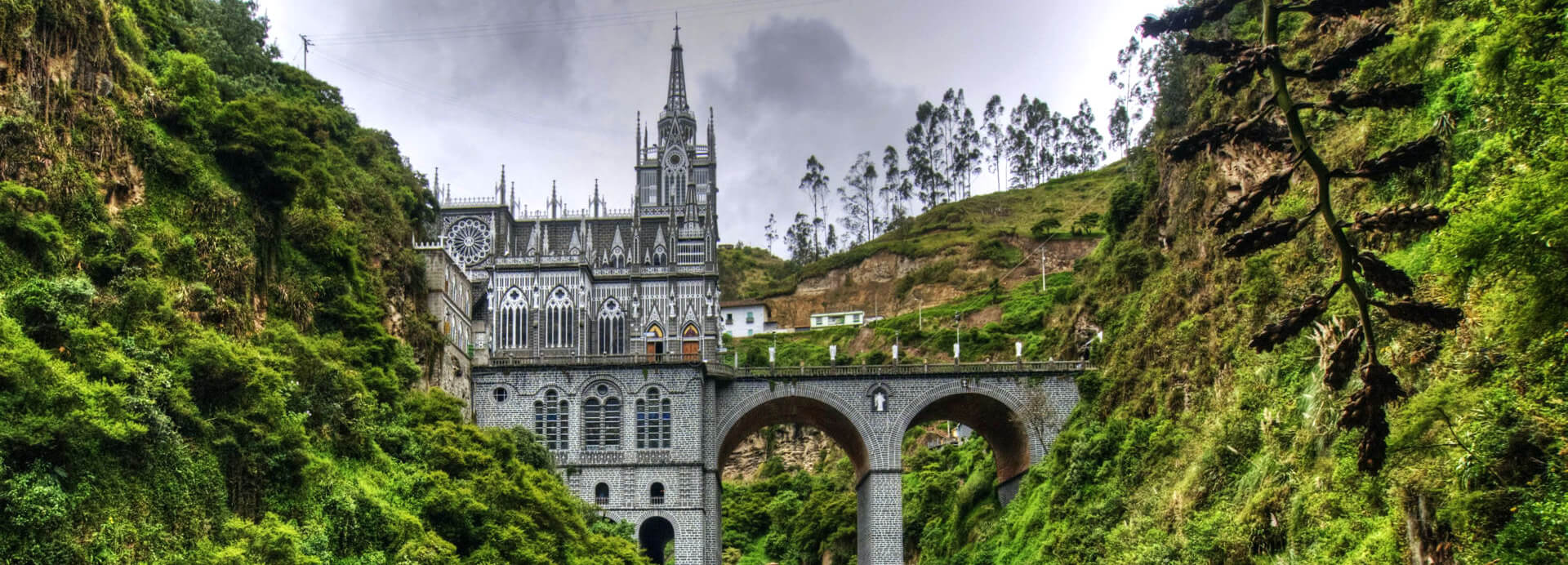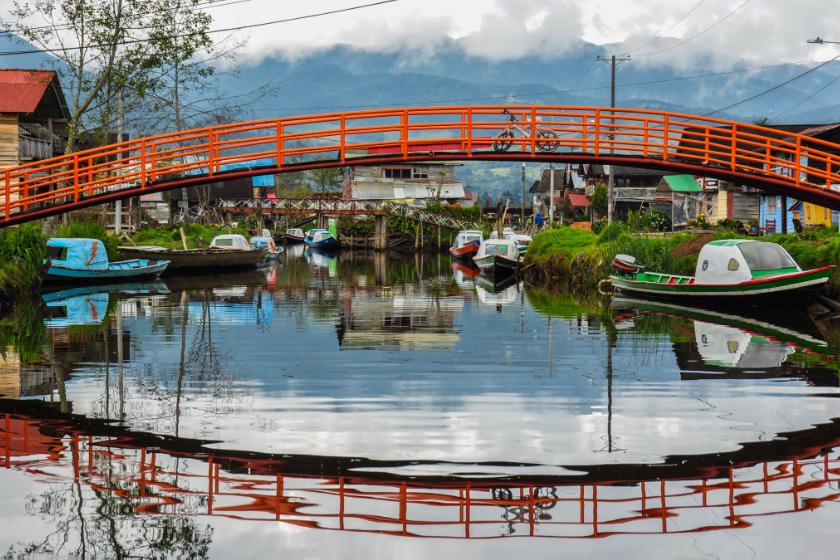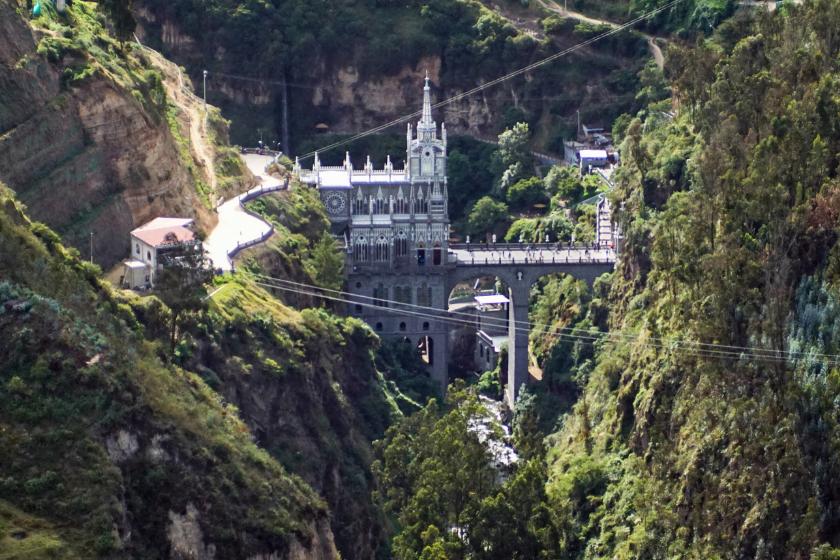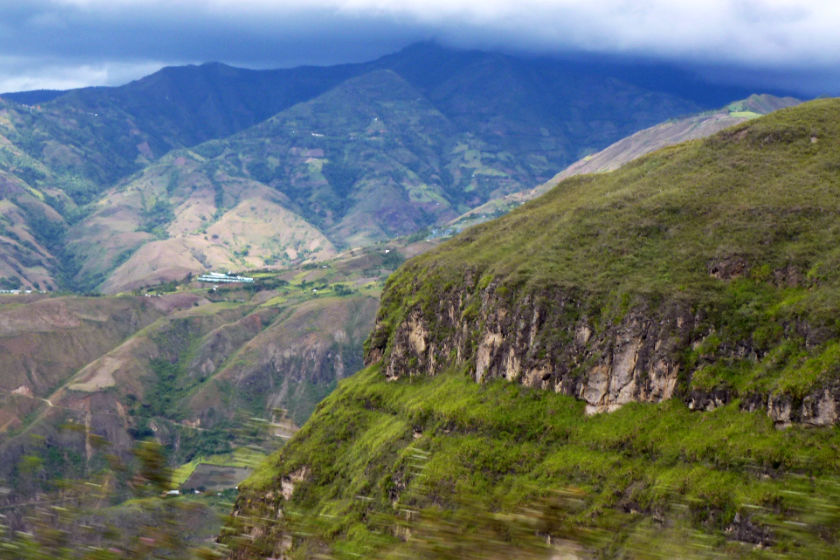
Where can you explore a breathtaking sanctuary perched on a cliffside, hike towering active volcanoes, and celebrate a vibrant carnival that blends indigenous traditions with Afro-Colombian rhythms? Pasto, Colombia, is a hidden gem, offering a unique blend of cultural and nature experiences you won’t find anywhere else.
High in the Andes Mountains, this unusual city hosts the unique Carnival of Blacks and Whites and is the gateway to the awe-inspiring Las Lajas Sanctuary, and some of Colombia’s most fascinating natural landscapes.
Pasto serves as an excellent hub for exploring this unique and often overlooked part of Colombia. Here are 6 top things to do in Pasto and 6 great day trips from Pasto!

Photo (mod.) by Jorgelrm, Pasto at night, CC BY-SA 3.0
Take a stroll through Pasto’s colorful old town, admire the beautiful historic building of the Nariño government, and soak in the lively atmosphere at Plaza de Nariño.
Among the attractions in the historical center are Pasto’s many gorgeous churches, including the baroque Iglesia San Juan Bautista, the 12th century La Merced Sanctuary, the colorful Templo San Felipe Neri, Iglesia San Augustin with its amazing altar, Templo de Cristo Rey, Iglesia de San Andrés, and the neoclassical cathedral Sagrado Corazón de Jesús.

Photo (mod.) by Carolina Obando Paz, view over Pasto, CC BY-SA 3.0
Nariño boasts a rich and diverse cultural heritage shaped by indigenous, African, and Spanish influences. The region is particularly known for its exquisite handicrafts, including wood carvings, pottery, and textiles. Visit one of Pasto’s fine museums to learn more about the regions history and culture.
Here are 3 great museums in Pasto:

Photo (mod.) by Jauder, Casa Taminango Museum Pasto, CC BY-SA 3.0
Pasto’s unique Carnaval de Negros y Blancos (Carnival of Blacks and Whites) is recognized as a UNESCO Intangible Cultural Heritage. It was born during the colonial period as a way for Afro-Colombian people to express their cultural identity and heritage. The use of black and white represents the fusion of different cultures, and stands for diversity and unity.
If you are not around during carnival time, you can still visit the spectacular Carnaval de Negros y Blancos Museum which features imaginative costumes and masks, and teaches you about the carnival’s fascinating history.

Photo (mod.) by Tapiz de Retazos, Carnaval de Negros y Blancos Pasto, CC BY-SA 2.0
Indulge in the local cuisine – unless you are a vegetarian or vegan… Traditional dishes of Pasto and the region include “cuy asado” (roasted guinea pig), “cuyaco” (soup with cuy), “fritada” (fried pork), “carnes al carbón” (grilled meats), “queso de cabeza” (cold meat) and “trucha al ají” (spicy trout). Vegetarians have the option to try the typical “torta de choclo” (corn cake). Good places to try the local cuisine are the historical center and Avenida de los Estudiantes.
Nariño is one of Colombia’s important coffee producing regions featuring a distinct taste due to its unique geographical characteristics and volcanic soil. Taste delicious regional coffee in local cafes, like La Catedral Cafe (Google Maps) in the historic center or Caffeto (Google Maps) on Avenida de los Estudiantes.
Discovering Colombian art is always a highlight and every city features talented artists with a distinct style, often addressing societal challenges and paying homage to their cultural heritage. Explore the unique murals of Pasto and buy small pieces of elaborate art pieces made by local artists and artisans. Try to attend a dance or music performance at a local venue or cultural center, such as Teatro Imperial, Casa Taminango, or Casa de la Cultura.

Photo (mod.) by Carlos Adampol Galindo, Street Art Pasto, CC BY-SA 2.0
Below you will find suggestions for things to see and do in the surroundings of Pasto, within a radius of less than 3 hours by taxi/bus. For some of them, organized tours are available from Pasto.
The enchanting Laguna La Cocha is the second-largest natural lake in Colombia and is home to the protected small volcanic island La Corota. Visit the island for spectacular hikes amidst its diverse flora and fauna, take boat tours to enjoy beautiful views of the lake and the surrounding mountains, search for rare birds, or just enjoy the serene tranquility of the lagoon and the fresh mountain air. Near the lagoon and the village Elcano you can also find the hidden waterfall Quillinzayaco.
An easy way to get to the lagoon and learn about its history is an organized tour from Pasto. Check out this top rated Cocha Lake small group tour at Civitatis*.

Photo by Hbrizard, Laguna La Cocha (mod.), Canva Pro
Situated near the border with Ecuador, the remarkable Las Lajas Sanctuary features an extraordinary setting. Perched on a bridge spanning a deep river gorge, the church creates an awe-inspiring and almost surreal impression.
The same local tour provider who offers the Cocha lake tour also runs a tour from Pasto to Las Lajas, which includes a visit to the iconic Tulcán cemetery in Ecuador and other interesting activities. Check it out at Civitatis*.

Photo by ANPerryman, Las Lajas Sanctuary (mod.), Canva Pro
The water-rich Galeras Nature Sanctuary (Santuario de Fauna y Flora Galeras) is home to one of the most active volcanoes in Colombia and encompasses diverse ecosystems, from cloud forests to paramos and snowcapped mountains.
While it’s not possible to trek all the way up to the active summit of the volcano, the area around the Telpis Lagoon is open to visitors. Here you can hike, birdwatch, enjoy and photograph panoramic views, and learn about the ecosystems from local guides. If you want to spend the night in this pristine natural setting, you can stay in cozy rural houses in the Telpis area.
In this local tour (Civitatis*) you can visit several traditional villages around the volcano and enjoy the views of the amazing landscape from different angles.

Photo (mod.) by Javier Narváez, Galeras Volcano near Pasto, Canva Pro
Hike to the mesmerizing Laguna Verde which hides in the crater of the Azufral Volcano, 4,070 meters above the sea. The trek is challenging but the reward is absolutely worth it: the dreamlike emerald-green crater lake is considered one of the most beautiful spots in Colombia. The Regional Natural Park Volcán Azufral also features other lagoons and a rich flora and fauna.
The hike to Laguna Verde begins near Túquerres. While Túquerres can be reached in 2 hours by car from Pasto, the bus journey usually takes a bit longer. Please verify the opening hours before traveling to Túquerres, as parks and reserves in Colombia may occasionally close to give nature time to recover.

Photo by Jeyson Diaz, CC BY-SA 4.0, Azufral (mod.)
Set in a stunning valley with a river and lush Andean hills, the Juanambú Canyon Park (Parque Cañón de Juanambú) offers outdoor activities like rafting, kayaking, hiking, rappelling, canopying and more. With three thermal pools and camping facilities, it’s an ideal destination for adventure lovers, close to Buesaco.
Just about 45 minutes from Pasto, in the region of Buesaco and Tablón de Gomez, you can visit coffee fincas to learn about the coffee cultivation and production process. It’s a great opportunity to get to know and support small Colombian coffee growers from Nariño. Check out Finca El Paraiso (Google Maps), known for their specialty coffee.
The historic center is a great place to stay with a good choice of accommodations. It’s ideal for solo travelers since you are close to the major attractions and a lot of restaurants and cafés. If you prefer a quieter area, you can check out the North of Pasto close to the carnival museum.
Here are some nice options featuring convenient locations:
Getting to Pasto by bus from other Colombian cities is cheap and easy as a solo traveler, as is moving around Pasto by bus or taxi.
When moving around Pasto on your own, take your usual travel precautions, like not walking around alone after dark or in isolated areas. While Pasto is generally considered safe to visit, safety levels can vary depending on specific areas and current general security situation in the area. Check out my safety tips for Colombia and tips for traveling alone in Colombia.
Tours in Colombia often require several participants to take place so you may want to get organized with other solo travelers. Also, some places in the surroundings of Pasto are faster and easier to reach by taxi or private transport – splitting costs makes these options very accessible.
The unique Carnival of Blacks and Whites takes place between January 2nd and 6th each year, with pre-carnival activities starting right after Christmas. Be aware that this is high-season in Pasto and prices go up.
Weatherwise, the temperature is rather stable throughout the year, with daytime temperatures fluctuating around 19°C/20°C (66°F/68°F) and nighttime temperatures around 9°C (48°F). The least rain typically falls between June and August (dry season), while April, October, and November see the most rain.

Photo (mod.) by tacowitte, Puracé National Park on the road Pasto – Popayán, CC BY-SA 2.0
Here are some travel destinations that are easy to reach for solo travelers by bus or minibus from Pasto.
Mocoa: The capital of the untapped Putumayo region is a great gateway into the Colombian Amazon and lets you experience impressive waterfalls, lush rainforests, and fascinating jungle flora and fauna. The bus from Pasto to Mocoa takes about 5 hours (see details on Rome2Rio).
Popayán: The beautiful colonial “white city” of Popayan enchants with its picturesque old town, delicious climate and gorgeous natural surroundings. It’s a great stop on your way to the Archeological Park in San Augustin. You may plan a visit to the impressive Purace National Park when traveling from Pasto to Popayan. The journey from Pasto to Popayan by minibus (colectivo) or regular bus should take around 6-8 hours. Check out Activities in and near Popayán.
Ipiales: Ipiales is located at the border with Ecuador. You can get to Ipiales from the Pasto main bus terminal by minibus (colectivo) in around 2-4 hours and then move on to Tulcan in Ecuador. In Tulcan you can catch a bus to Otavalo, which is one of Ecuador’s top tourist attractions. Please check current security advice for the Colombia-Ecuador border beforehand.
Share this post:
Last Update: August 24, 2025
Image Credit: Title image (top) from pxfuel & Rare Gallery, Las Lajas Sanctuary, Pasto Colombia
*Affiliate links: Some links on this page are affiliate links. If you choose to book through these links, you can support my work on Travelhapp – at no extra cost to you. I only recommend products and services I trust and believe will provide value to you.
© 2025 Travelhapp.com
To provide the best experiences, we use technologies like cookies to store and/or access device information. Consenting to these technologies will allow us to process data such as browsing behavior or unique IDs on this site. Not consenting or withdrawing consent, may adversely affect certain features and functions. View our Privacy & Cookie Policy